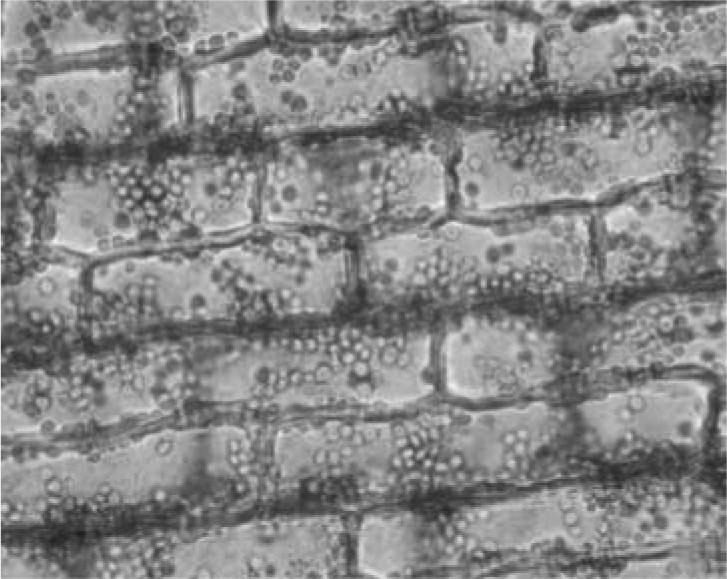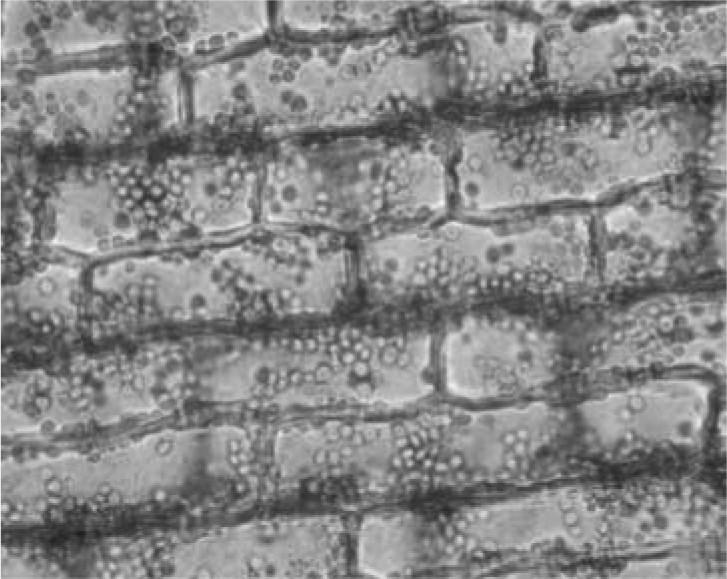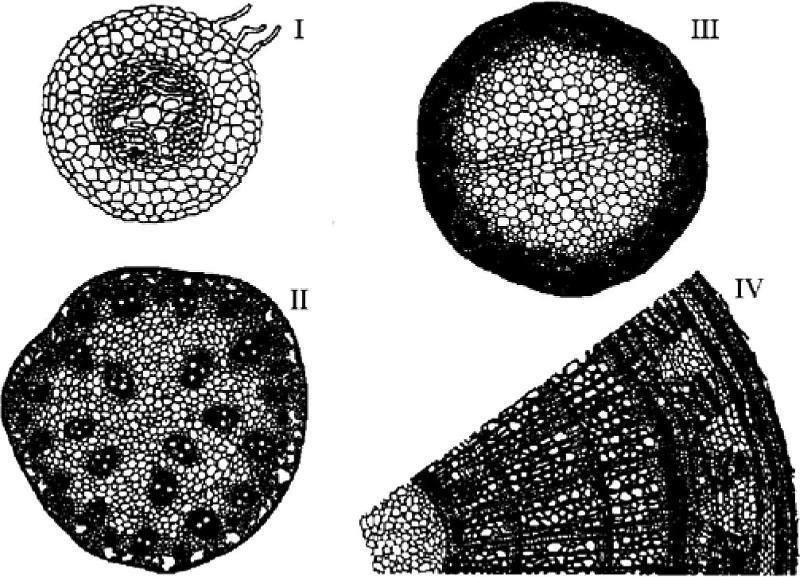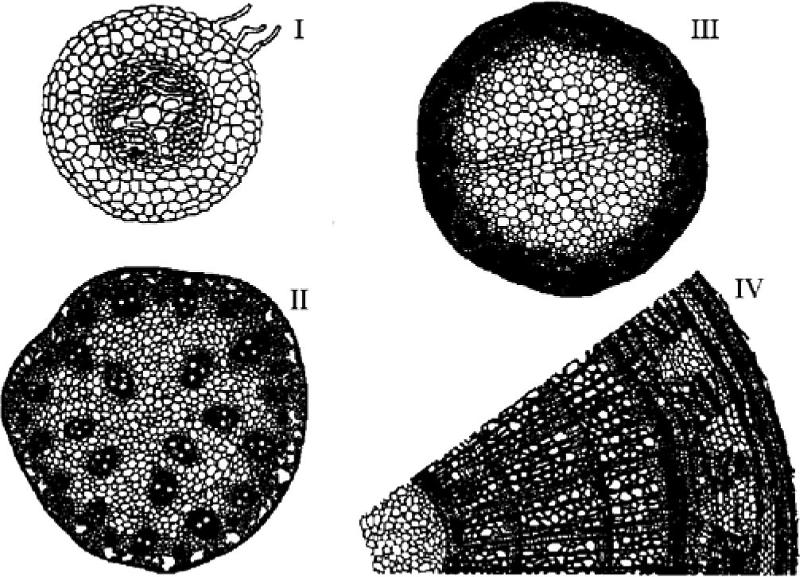Root hairs, which absorb the water and minerals in the majority of plants, are the extensions of root
- A) collenchyma tissue.
- B) pericycle.
- C) endodermis.
- D) epidermal cells.
- E) parenchyma.
D
Palisade parenchyma, a ground tissue, performs which of the following functions?
- A) storage of food
- B) photosynthesis
- C) aerobic respiration
- D) transport of water and minerals
- E) transport of food
B
Which of the following is derived from the ground tissue system?
- A) root hair
- B) cuticle
- C) periderm
- D) pith
- E) phloem
D
Adventitious roots in monocots are very helpful in coastal ecosystems to reduce
- A) water absorption.
- B) evaporation.
- C) soil erosion.
- D) nutrient absorption.
- E) decomposition.
C
An association between the roots of a terrestrial plant with soil fungus is referred as
- A) parasitism.
- B) symbiosis.
- C) autotrophism.
- D) heterotrophism.
- E) saprobism.
B
Storage roots, stems, and leaves are some of the evolutionary adaptations of plants. Which of the following are listed in the order of modified root, stem, and leaf?
- A) rhizome, bulb, tuber
- B) bulb, stolon, spine
- C) rhizome, stolon, tendril
- D) stolon, rhizome, bulb
- E) tendril, rhizome, spine
C
Guard cells of stomata in leaves of plants are modified
- A) mesophyll cells.
- B) epidermal cells.
- C) palisade mesophyll cells.
- D) sclerenchyma cells.
- E) collenchyma cells.
B
Which tissue is responsible for the recovery and rapid growth of damaged leaves of grass grazed by sheep in a pasture?
- A) parenchyma
- B) apical meristem
- C) axillary buds
- D) mesophyll
- E) intercalary meristem
E
The outermost layer of the vascular cylinder of a root is called the
- A) pericycle.
- B) cortex.
- C) xylem.
- D) phloem.
- E) endodermis.
A
Mesophyll in leaves is located between the
- A) epidermis and endodermis.
- B) epidermis and xylem.
- C) phloem and epidermis.
- D) stomata and mesophyll.
- E) upper and lower epidermis.
E
The role of genes and their activation and inactivation during cell differentiation is based on
- A) cell-to-cell communication.
- B) cell division.
- C) cell elongation.
- D) cell growth.
- E) cell development.
A
Secondary growth in eudicot stems and roots is caused by
- A) apical meristem.
- B) axillary bud.
- C) lateral meristem.
- D) secondary xylem.
- E) secondary phloem.
C
Which of the following environmental factors plays a critical role in plant photosynthesis?
- A) CO2and O2
- B) O2and light
- C) O2and chlorophyll in mesophyll
- D) light and CO2
- E) light, chlorophyll, and CO2
D
Which tissue is the innermost layer of the cortex in roots?
- A) pericycle
- B) endodermis
- C) vascular cylinder
- D) mesophyll
- E) ground tissue
B
Which of the following tissues played a very critical role in the process of evolution to produce the great biodiversity of flowering plant species?
- A) lateral meristem
- B) apical meristem
- C) mesophyll
- D) endodermis
- E) xylem and phloem
A
The strength and hardness of wood are due to
- A) secondary growth.
- B) highly lignified walls of secondary phloem.
- C) highly lignified walls of xylem.
- D) annual rings.
- E) tracheids.
C
Mature cork cells deposit a waxy substance called ________ in cell walls.
- A) suberin
- B) lignin
- C) chitin
- D) cellulose
- E) pectin
A
The vascular cambium is ________ and produces secondary vascular tissue.
- A) one cell thick
- B) two cells thick
- C) three cells thick
- D) irregular in thickness
- E) composed of multiple layers
A
Which part of a plant absorbs most of the water and minerals taken up from the soil?
- A) root cap
- B) root hairs
- C) the thick parts of the roots near the base of the stem
- D) storage roots
- E) sections of the root that have secondary xylem
B
Which cells are no longer capable of carrying out the process of DNA transcription?
- A) tracheids
- B) mature mesophyll cells
- C) companion cells
- D) meristematic cells
- E) glandular cells
A
________ is to xylem as ________ is to phloem.
- A) Sclerenchyma cell; collenchyma cell
- B) Apical meristem; vascular cambium
- C) Vessel element; sieve-tube member
- D) Cortex; pith
- E) Vascular cambium; cork cambium
C
Which of the following tissue types transport water and minerals over long distances in angiosperms?
- A) parenchyma cells
- B) collenchyma cells
- C) sclerenchyma cells
- D) vessel elements
- E) sieve-tube elements
D
Which of the following have unevenly thickened primary walls that support young, growing parts of the plant and provide flexibility?
- A) parenchyma cells
- B) collenchyma cells
- C) sclerenchyma cells
- D) tracheids and vessel elements
- E) sieve-tube elements
B
Which of the following are most responsible for supporting mature, nongrowing parts of the plant?
- A) parenchyma cells
- B) collenchyma cells
- C) trichomes
- D) tracheids and vessel elements
- E) sieve-tube elements
D
The vascular bundle in the shape of a single central cylinder in a root is called the
- A) cortex.
- B) stele.
- C) endodermis.
- D) periderm.
- E) pith.
B
One important difference between the anatomy of roots and the anatomy of leaves is that
- A) only leaves have phloem and only roots have xylem.
- B) root cells have cell walls and leaf cells do not.
- C) leaves have mesophyll tissue but roots do not.
- D) vascular tissue is found in roots but is absent from leaves.
- E) leaves have epidermal tissue but roots do not.
C
A student examining leaf cross sections under a microscope finds many loosely packed cells with relatively thin cell walls. The cells have numerous chloroplasts. What type of cells are they?
- A) parenchyma
- B) xylem
- C) endodermis
- D) collenchyma
- E) sclerenchyma
A
Which of the following cell types retains the ability to undergo cell division?
- A) a sclereid
- B) a parenchyma cell 2 mm from the tip of a root
- C) a functional sieve-tube element
- D) a tracheid
- E) a stem fiber
B
Axillary buds
- A) are initiated by the cork cambium.
- B) have dormant meristematic cells.
- C) are composed of a series of internodes lacking nodes.
- D) grow immediately into shoot branches.
- E) do not form a vascular connection with the primary shoot.
B
A plant has the following characteristics: a taproot system, several growth rings evident in a cross section of the stem, and a layer of bark around the outside. Which of the following best describes the plant?
- A) herbaceous eudicot
- B) woody eudicot
- C) woody monocot
- D) herbaceous monocot
- E) woody annual
B
Compared to most animals, the growth of most plants is best described as
- A) perennial.
- B) weedy.
- C) indeterminate.
- D) derivative.
- E) primary.
C
Lateral meristems produce
- A) dermal and ground tissue.
- B) lateral tissues.
- C) pith.
- D) secondary tissues.
- E) shoots and roots.
D
Plants contain meristems whose major function is to
- A) attract pollinators.
- B) absorb ions.
- C) photosynthesize.
- D) produce more cells.
- E) produce flowers.
D
Which of the following statements about growth in plants is true?
- A) Primary growth is localized at meristems, whereas secondary growth is localized at buds.
- B) Some plants lack secondary growth.
- C) Secondary growth occurs only in stems.
- D) Reproductive structures are produced by secondary growth.
- E) Monocots have only primary growth, and eudicots have only secondary growth.
B
Additional vascular tissue produced as secondary growth in a root originates from which cells?
- A) vascular cambium
- B) apical meristem
- C) endodermis
- D) phloem
- E) xylem
A
Lateral meristem activity results in production of
- A) secondary xylem.
- B) leaves.
- C) trichomes.
- D) tubers.
- E) cortex.
A
Which of the following is a true statement?
- A) Flowers may have secondary growth.
- B) Secondary growth is a common feature of eudicot leaves.
- C) Secondary growth is produced by both the vascular cambium and the cork cambium.
- D) Primary growth and secondary growth alternate in the life cycle of a plant.
- E) Plants with secondary growth are typically the smallest ones in an ecosystem.
C
Gas exchange, which is necessary for photosynthesis, can occur most easily in which leaf tissue?
- A) epidermis
- B) palisade mesophyll
- C) spongy mesophyll
- D) vascular tissue
- E) bundle sheath
C
CO2 enters the inner spaces of the leaf through the
- A) cuticle.
- B) epidermal trichomes.
- C) stoma.
- D) phloem.
- E) walls of guard cells.
C
The driving force that pushes the root tip through the soil is primarily
- A) continuous cell division in the root cap at the tip of the root.
- B) continuous cell division just behind the root cap in the center of the apical meristem.
- C) elongation of cells behind the root apical meristem.
- D) the elongation of root hairs.
- E) continuous cell division of root cap cells.
C
The shoot elongation in a growing bud is due to
- A) cell division at the shoot apical meristem.
- B) cell elongation directly below the shoot apical meristem.
- C) cell division localized in each internode.
- D) cell elongation localized in each internode.
- E) cell division at the shoot apical meristem and cell elongation directly below the shoot apical meristem.
D
The following question is based on parts of a growing primary root.
- root cap
- zone of elongation
III. zone of cell division
- zone of cell differentiation
- apical meristem
Which of the following is the correct sequence from the growing tips of the root upward?
- A) I, II, V, III, IV
- B) III, V, I, II, IV
- C) II, IV, I, V, III
- D) IV, II, III, I, V
- E) I, V, III, II, IV
E
Which of the following root tissues gives rise to lateral roots?
- A) endodermis
- B) phloem
- C) cortex
- D) epidermis
- E) pericycle
E
Pores on the leaf surface that function in gas exchange are called
- A) hairs.
- B) xylem cells.
- C) phloem cells.
- D) stomata.
- E) sclereids.
D
A person working with plants may increase the lateral branches by which of the following?
- A) pruning shoot tips
- B) deep watering of the roots
- C) fertilizing
- D) treating the plants with auxins
- E) feeding the plants nutrients
A
The dominant type of tissue that makes up most of the wood of a tree is
- A) primary xylem.
- B) secondary xylem.
- C) secondary phloem.
- D) mesophyll cells.
- E) vascular cambium.
B
If you were able to walk into an opening cut into the center of a large redwood tree, when you exit from the middle of the trunk (stem) outward, you would cross, in order,
- A) the annual rings, new xylem, vascular cambium, phloem, and bark.
- B) the secondary xylem, cork cambium, phloem, and periderm.
- C) the vascular cambium, oldest xylem, and newest xylem.
- D) the secondary xylem, secondary phloem, and vascular cambium.
- E) the summer wood, bark, and phloem.
A

Which of the following statements about the cells shown in the photograph in Figure 28.1 is true?
- A) They are parenchyma cells.
- B) They are photosynthetic.
- C) They are usually found in roots.
- D) They are phloem cells.
- E) They are parenchyma cells and photosynthetic.
E

The characteristic feature of typical parenchyma tissue is
- A) a thick cell wall.
- B) large intercellular space.
- C) lignin filled intercellular spaces.
- D) inability to divide.
- E) transportation.
B

A monocot stem is represented by
- A) I only.
- B) II only.
- C) III only.
- D) IV only.
- E) both I and III.
B

A plant that is at least 3 years old is represented by
- A) I only.
- B) II only.
- C) III only.
- D) IV only.
- E) both I and III.
D

A typical eudicot root is represented by
- A) I only.
- B) II only.
- C) III only.
- D) IV only.
- E) both I and III.
A
Suppose George Washington completely removed the bark from around the base of a cherry tree but was stopped by his father before cutting the tree down. The leaves retained their normal appearance for several weeks, but the tree eventually died. The tissue(s) that George left functional was/were the
- A) phloem.
- B) xylem.
- C) cork cambium.
- D) cortex.
- E) companion and sieve-tube members.
B
As a youngster, you drive a nail in the trunk of a young tree that is 3 meters tall. The nail is about 1.5 meters from the ground. Fifteen years later, you return and discover that the tree has grown to a height of 30 meters. About how many meters above the ground is the nail?
- A) 0.5
- B) 1.5
- C) 3.0
- D) 15.0
- E) 28.5
B
Most of the growth of a plant body is the result of
- A) cell differentiation.
- B) cell division.
- C) morphogenesis.
- D) cell elongation.
D
The innermost layer of the root cortex is the
- A) core.
- B) pericycle.
- C) endodermis.
- D) pith.
C
Heartwood and sapwood consist of
- A) bark.
- B) periderm.
- C) secondary xylem.
- D) secondary phloem.
E) cork
C
Which of the following arise, directly or indirectly, from meristematic activity?
- A) secondary xylem
- B) dermal tissue
- C) leaves
- D) all of the above
D
Which of the following would not be seen in a cross section through the woody part of a root?
- A) sclerenchyma cells
- B) sieve-tube elements
- C) parenchyma cells
- D) root hairs
D